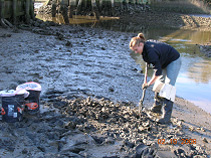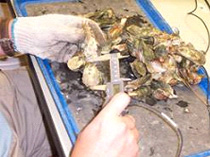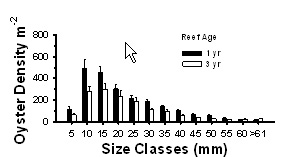The size frequency distribution of an oyster population is determined by measuring the shell height of each individual oyster within a collected sample – usually the same sample used to determine oyster density (see Figure). Additional dimensions can be measured to account for irregular oyster shapes (e.g., SC oysters can be very long and thin). A digital caliper system enables more than one investigator to collect measurements simultaneously as data are relayed to a database or spreadsheet for later analysis. The individual height measurements (±1.0 mm) are then grouped into size classes and can be used to estimate size (age) class changes over time.



Examples of quadrat sampled to a known depth (top left), oyster shell length (top right) measured using digital calipers and typical size frequency (bottom) plot for data (photos from D. Meyer and L. Coen).







